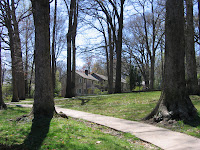 Quite a while back, I started the "Introducing Washington" feature to introduce Washington to you as I got to know it. The newest entry looks at Greenbelt, a quiet but notable suburb just outside the Beltway.
Quite a while back, I started the "Introducing Washington" feature to introduce Washington to you as I got to know it. The newest entry looks at Greenbelt, a quiet but notable suburb just outside the Beltway. America is littered with historical landmarks, but perhaps nowhere is so rich in history as the Northeast and Mid-Atlantic regions. When it comes to the built environment, Washington has long been one of the proving grounds for planning. From the formation of the planning movement at the National Planning Conference in 1909 to the demonstration of New Urbanism at Kentlands, it has been Washington that has benefited from planning ideas that often seemed far-fetched at the time.
Greenbelt, Maryland is no exception. Located near the junction of the Washington Beltway and the Baltimore-Washington Parkway, the town sits in a bucolic setting just a stone's throw from our national capital. Faced with housing shortages, a decimated economy, and deteriorating conditions in cities, the Roosevelt Administration, as a part of the New Deal, set out to build three "greenbelt towns" as an example of how suburban development could and should move forward.

Today, Greenbelt is a National Planning Landmark and is the best-preserved of the greenbelt towns. Little effort was made to preserve Greenbelt's sister cities Greenhills, Ohio and Greendale, Wisconsin until recently, leaving Greenbelt one of the only places to view New Deal era utopian town planning.
Partially inspired by England's garden city movement, Greenbelt was intended to be a self-contained community surrounded by a green belt of parks, forests, and farms. Today, Greenbelt is not as isolated, but the historic center maintains its park-like setting. Much of the original green belt was sold off by the federal government in the 1970s and 80s 1950s and has been developed in the typical suburban fashion.

Greenbelt is laid out on a beautiful site. Two parallel streets (Crescent and Ridge Roads) follow a reverse-'c' shaped ridge. Townhouses, apartments, and single-family detached houses are spread along these roads. At the center of the reverse-'c' is a man-made lake which is surrounded by parkland. The commercial center for the city is called the Roosevelt Center. It sits at the intersection of Crescent Road and Southway, the main entrance to the development. Adjacent to the Roosevelt Center are the Municipal Buildings Recreation Center, Elementary School/Community Center, and a Public Library. The Elementary School is now closed, and the entire building is the Community Center.

All residential buildings in Old Greenbelt have their main entrances on the "garden side." The design of the community meant that pedestrian paths would through superblocks, where buildings were turned inward toward parks, gardens, and social interaction. At the rear of the units is the street, the so-called "service side."

Separated pedestrian/bicycle paths connect the different superblocks with the Center, including 3 underpasses to keep cars and people apart. These paths also wind through the parkland and around the lake.
Construction on the site began in 1935, with occupancy beginning in 1937. When the initial construction was completed, more than 800 units had been built in Greenbelt. The United States' entry into the Second World War exacerbated Washington's housing shortage and 1,000 more homes were built beginning in 1941. After the federal government began to divest itself from the community in the early 1950s, a co-operative was formed to buy the units and maintain Greenbelt's unique way of life.
Greenbelt Homes, Incorporated still owns most of the original buildings in Old Greenbelt. Partially due to its history, Greenbelters are active in community organizations. In addition to the homes, the supermarket is also a co-operative.
Greenbelt was designed with the automobile in mind, but it was not designed for the automobile. I think this is the largest and most crucial difference between Greenbelt and the prototypical post-war suburb. The community is walkable, traffic is calm, and despite being surrounded by sprawl, cars do not dominate the landscape.

I regard it as the most tragic of missed opportunities that we were unable to build America's suburbs the way we built Greenbelt. Unlike other suburbs, Greenbelt does not suffer from a lack of interaction (Bowling Alone) or a lack of alternative transportation modes.
If you're interested in learning more about Greenbelt or visiting yourself, the town opened a museum in 1987. It's open Sundays from 1-5PM, and is located across Crescent from the Public Library.
Unfortunately, neither WMATA or Prince George's County Transit provide Sunday bus service to Greenbelt. However, the town is within biking distance of the Greenbelt Metro station. During the week and on Saturdays, you can take the C2 bus from Greenbelt Station or the R12 from New Carrollton.










1 comment:
Excellent post, although I might argue that there was a major alternative transportation fail when the put the "Greenbelt" Metro station in the middle of nowhwere off the Beltway, and virtually inaccessible to the town by walking or biking.
Post a Comment